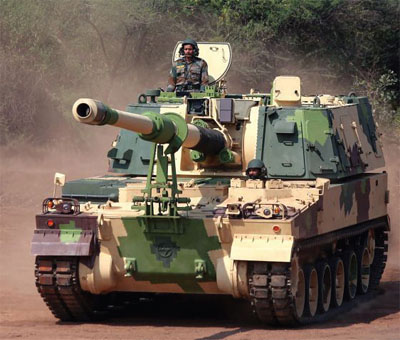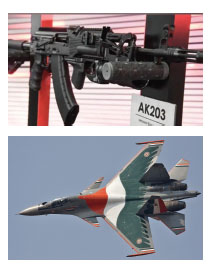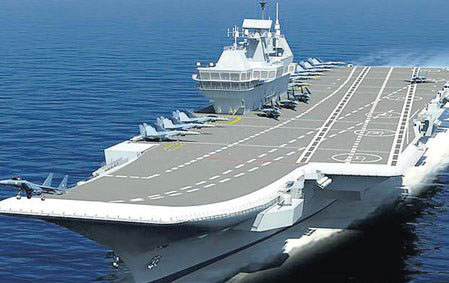The recently concluded G20 Summit at New Delhi brought many major militaries together. With robust domestic defence industrial capabilities, the group’s members included most of the world’s top twenty arms exporters. Defence remains a vital ingredient of a nations Comprehensive National Power (CNP), apropos, the Summit also reflected the emergence of India as one of the world’s leading military powers. Defence however, was discussed on the sidelines, in bilateral talks. The Delhi declaration stated that in line with the UN Charter all states must refrain from the threat, or use of force to seek territorial acquisition against the territorial integrity and sovereignty or political independence of any nation state. The carefully drafted Delhi Declaration went further to say; “Today’s era must not be of war”.
The Security Environment

China’s drive to establish its predominance in the Asia-Pacific, expanding naval fleet and nuclear arsenal, its advances in space, cyber and missile technologies, and threats to its neighbourhood is causing concern on multiple fronts. China is focussed at catching up militarily with USA, but it is axiomatic that India, because of its sheer proximity, cannot look the other way. Between India and China, asymmetries exist in almost all spheres; however purely in military terms China is far ahead. China is unlikely to fight a battle of attrition with India. China will initially concentrate on non- contact warfare and weaken India’s war waging capability in all spheres of military, economic and political space before committing its troops to contact warfare.
On the other hand, Pakistan, which has often been seen to be a failing state has continued in its present form and is unlikely to fail despite its serious internal issues. Irrespective, its military modernisation has kept pace due to the economic aid and military equipment it has received from China.
Pakistan is one enemy who will leave no stone unturned to score on India. Therefore, it would be prudent to keep an equal watch over the Western adversary, instead of concentrating totally on the Northern one. To continue to consider both countries separately, as two fronts, with the hope of tackling them one at a time, would be a fundamental mistake. The rhetoric of, we will fight on one front and manage the other diplomatically/politically must change, as no one can guarantee it. Similarly, it will tantamount to military imprudence, if our planning is based on moving troops from one theatre to another. Our troops need to be fixed and dedicated to specific fronts, as all theatres will be simultaneously active in case of war. In case some theatre is dormant, then that would be by design. We must consider both China and Pakistan as one front, one enemy. Therefore, to counter such threat we need a strong defensive posture on all fronts. Hence, the need to build up our military capability expeditiously.

To believe that there will be no war, or war can be averted is a disastrous fallacy. In our own lifetime, how many conflicts have we witnessed and are currently witnessing? There were many believers that Russia would never attack Ukraine. The only way that you can avoid war, is to prepare for it. The fact is that man has always fought man. To fight better, man has been in the quest to make better weapons. From sticks and stones, to swords and spears, to chariots and elephants, to gunpowder and cannons and artillery, to matchlocks and rifles, to battleships, to tanks, to submarines, to fighter aircraft and missiles, and then to nuclear power. In today’s context from perception warfare, to cyber warfare, to space warfare, to drone warfare, the quest is never ending.
Our military resolve has been demonstrated during Uri, Balakot, Doklam and Galwan. However, our resolve needs to be backed by a strong deterrence of our Armed Forces in terms of their capabilities, training, doctrines, equipment, technology, manufacturing, and military cooperation with other nations. Such a deterrence will always be far cheaper than the cost of war.
In full understanding and knowledge of this predicament, the Indian establishment has started taking steps in the right direction, more than ever before. Some of the ongoing initiatives are discussed below.
India Equipping Itself Across all Verticals
In order to meet the challenges posed by the environment, the Indian Defence Forces are suitably equipping themselves with upgradations and modernization of existing weapon systems, induction of new technologies as well as purchase of new weapons systems. New procurement is also necessary in order to fill the voids created by the phasing out of obsolete inventory. The intent is to furnish the military with world-class equipment and training, a testament to the nation’s unyielding spirit to overcome any challenge.

Ground Forces. The Army has recently invited proposals for guns, missiles, drones, counter-drone systems, loiter munition, communication and optical systems, specialist vehicles, engineering equipment and alternate energy resources based on compressed timelines. In mid-September the Defence Acquisition Committee (DAC), in order to enhance protection, mobility, attack capability and increase survivability of mechanised forces, accorded the approval for procurement of Light Armoured Multipurpose Vehicles (LAMV) and Integrated Surveillance and Targeting System (ISAT-S). Some of the other projects are given below:
Artillery. The IA is in the process of converting Artillery regiments to a mix of 155mm/39 calibre, 155mm/45 calibre, and 155mm/52 calibre gun profile. India is focusing on long-range firepower and precision-strike capabilities.
As a significant step towards enhancing the artillery’s shoot and scoot capabilities, the procurement of approximately 300, 155mm/52 calibre, indigenous advanced towed artillery gun systems (ATAGS) and 300 mounted gun systems (MGS) has already commenced. Additionally, the IA is acquiring another 100, K-9 Vajra self-propelled tracked guns, through the joint venture between L&T and South Korean Hanwha Defence. In another initiative, under the Sharang project the OFB is upgrading 130mm M46 towed artillery pieces to 155mm/45-calibre standard.
On the Sidelines of G-20
Indo-US. The commencement of negotiations for a commercial agreement between GE Aerospace and HAL to manufacture GE F-414 jet engines in India was announced.
Both countries recommitted to advancing India’s emergence as a hub for the maintenance and repair of forward-deployed U.S. Navy assets and other aircraft and vessels.
During their bilateral meet, Prime Minister Modi and President Biden reaffirmed their commitment to deepen and diversify the India-US Defence Partnership. President Biden welcomed the order of 31 General Atomics MQ-9B (16 Sky Guardian and 15 Sea Guardian) from USA.
France & India. During their meeting at the G20 summit, Prime Minister Narendra Modi and French President Emmanuel Macron expressed their commitment to enhancing the defence cooperation between India and France. In July, India had given approval for the purchase of the naval variant Rafale jets from France, as well as for the procurement of three French-designed Scorpene class submarines.
Indo-Japan. Prime Minister Fumio Kishida of Japan said that he saw India as an “indispensable” partner in the Indo-Pacific and Japan is keen to develop deeper defence cooperation to ensure maritime security in the region.
He emphasized the importance of joint exercises to ensure the Indo-Pacific will be a region that values freedom and rule of law. As regards the new Free and Open Indo-Pacific (FOIP) strategy, he said “India is an indispensable partner to realise FOIP.”
India-Nigeria. Defence Minister Rajnath Singh had discussions with President Tinubu of Nigeria, regarding defence deals worth over $1 billion dollars. Nigeria showed interest in LCA Tejas, and Armoured Personnel Carriers.

India also plans to induct more regiments of the BrahMos supersonic cruise missiles, whose range has been extended to 450 Km. The Army is also set to receive the latest 500 Km range, Pralay ballistic missiles. A complete revamp of the surveillance and target acquisition regiments is underway to arm the units with the latest equipment, including remotely piloted vehicles and swarm drones.
Air Defence. The Russian Ambassador to India, Denis Alipov’s announced last month that the “S-400s will be delivered on time”. India and Russia signed a contract in October 2018 for delivery of five sets of S-400 system, with a command post and two batteries of eight launchers each. Russia has so far delivered three sets. The remaining two are to be delivered by the end of 2023. The highly mobile and automated S-400, can track 100 – 300 targets simultaneously, and can be used to protect vital areas during war.
AK-203 Assault Rifle. Addressing the urgent requirement to replace the INSAS rifle, the Korwa Rifle Factory in Amethi has been upgraded with a modern production line, where the latest version of the Kalashnikov rifles is to be manufactured. The rifles are being manufactured with a complete ToT clause. Over a period, the factory will deliver over 7,00,000 rifles. The manufacturing will be done by the Indo Russian Rifles Private Limited, Joint Venture between Advanced Weapons and Equipment India Ltd and Russian Rosoboronexport.
Indian Air Force. In the air, both technology and numbers matter. China is way ahead in both. Pakistan is steadily building up its Air Force, having placed an order for 162, J 17 and 36, J 10CE fighter aircraft from China, it’s strength will increase to 32 squadrons. Thereby, in numbers near parity would have been achieved by Pakistan. There is no doubt that the Rafael is hard to match, but numbers need to increase.
To assess the true capability of any Air Force one must look at Air Defence, AWACS, Air to Air refuelling capability, Helicopters, Ground defence, Airfield infrastructure, Airlift capability, logistical and supply chains, modification and testing facilities and training levels: All these attributes come together for an air force to become a balanced and effective force. Each of these attributes need to be independently audited to ensure that it does not become a weak link in the system. India is in the process of upgrading systematically in all disciplines.
Apart from the ongoing induction of the Rafale fighters, the induction of the MRCA and modernization of its transport fleet which has seen recent inductions of the C-17, C-130, Chinooks and now C-295.

On 15 September 2023 the Defence Ministry cleared procurement of various weapons systems and platforms including Dhruvastra short range air-to-surface missile and 12 Su-30 MKI fighter jets. The avionic upgrade of Dornier aircraft was also given Acceptance of Necessity (AoN). The IAF is looking for domestic manufacturers to upgrade Israeli Heron with more capabilities including weaponised payloads.
Designed and developed by Hindustan Aeronautics Limited (HAL), ‘Prachand’, India’s first indigenous multi-role, light combat helicopter (LCH) was inducted into the IAF in October 2022.
The IAF on 13 Sep 23 took the delivery of its first C-295 transport aircraft from Airbus Defence and Space, at Seville in Spain. C-295 is a new generation, twin-turboprop, tactical transport aircraft. The aircraft has a flight endurance of up to 11-13 hours with a range of 5,630 Km. The aircraft can carry up to nine tonnes of payload or 71 troops or 45 paratroopers at a cruise speed of 260 knots.
India had contracted (₹21,935-crore project) for 56, C 295s in Sep 2021. The first 16 aircraft are to be delivered in fly-away condition over four years from the date of contract. The remaining 40 aircraft will be manufactured by Tata Advanced Systems in India under an industrial partnership with Airbus.
On 16 September the DAC cleared the acquisition of 12 Su-30MKI fighter jets for the IAF. Hindustan Aeronautics Limited, will manufacture the fighters in India. All raw material needed for the Su-30MKI, will come from Russia. The jets will include several avionic and communication instruments of Indian origin and they will be integrated with domestically produced weapon systems.
Indian Navy. With the increased Chinese footprint in the Indian Ocean, it is imperative that the Indian Navy strengthen its capabilities at sea. IN needs urgent upgradation from Aircraft Carrier(s) to naval helicopters. India’s first indigenous aircraft carrier INS Vikrant was commissioned by Prime Minister Narendra Modi at Cochin Shipyard Limited in September 2022. It has a crew of around 1,600 officers and sailors and an Air Wing consisting of thirty assorted aircraft.
Indian Naval Air Squadron 325, operating the indigenously built advanced light helicopter Mk-III, was recently commissioned into the IN. The helicopters can undertake maritime reconnaissance as well as carry out search and rescue at extended ranges while operating from ships, both by day and night.
Another two frontline warships, ‘Surat’ a Stealth-Guided Missile Destroyer, and ‘Udaygiri’ a Stealth Frigate were launched at Mazagon Docks in May 23.
Adding a new dimension to the Indo-US strategic partnership, US Navy Ship, Charles Drew visited L&T’s Shipyard at Kattupalli, Chennai in August for undertaking repairs and allied services. This was the first ever repair of a US Navy ship in India.
Conclusion
Having identified the collusive threat from China and Pakistan, in any future conflict with one, the other will be involved. The extent of involvement may vary depending on the prevailing circumstances. Therefore, India needs to immediately carry out modernisation of its Defence Forces to meet the challenge. The status quo must change. Undoubtedly, the current disposition has taken long overdue steps to improve our defence preparedness, however, some of our procedures are detrimental to the cause. A former Defence Secretary while highlighting the changes in policies stated, that his efforts were to reduce the procurement periods from an average of five to six years to two to three years. In such an uncertain and hostile environment, is three years acceptable?
ABOUT THE AUTHOR
![]() Maj Gen VK Singh, VSM was commissioned into The Scinde Horse in Dec 1983. The officer has commanded an Independent Recce Sqn in the desert sector, and has the distinction of being the first Armoured Corps Officer to command an Assam Rifles Battalion in Counter Insurgency Operations in Manipur and Nagaland, as well as the first General Cadre Officer to command a Strategic Forces Brigade. He then commanded 12 Infantry Division (RAPID) in Western Sector. The General is a fourth generation army officer.
Maj Gen VK Singh, VSM was commissioned into The Scinde Horse in Dec 1983. The officer has commanded an Independent Recce Sqn in the desert sector, and has the distinction of being the first Armoured Corps Officer to command an Assam Rifles Battalion in Counter Insurgency Operations in Manipur and Nagaland, as well as the first General Cadre Officer to command a Strategic Forces Brigade. He then commanded 12 Infantry Division (RAPID) in Western Sector. The General is a fourth generation army officer.
![]() Major General Jagatbir Singh was commissioned into 18 Cavalry in December 1981. During his 38 years of service in the Army he has held various command, staff and instructional appointments and served in varied terrains in the country. He has served in a United Nations Peace Keeping Mission as a Military Observer in Iraq and Kuwait. He has been an instructor to Indian Military Academy and the Defence Services Staff College, Wellington. He is a prolific writer in defence & national security and adept at public speaking.
Major General Jagatbir Singh was commissioned into 18 Cavalry in December 1981. During his 38 years of service in the Army he has held various command, staff and instructional appointments and served in varied terrains in the country. He has served in a United Nations Peace Keeping Mission as a Military Observer in Iraq and Kuwait. He has been an instructor to Indian Military Academy and the Defence Services Staff College, Wellington. He is a prolific writer in defence & national security and adept at public speaking.